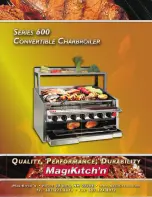
5
2.0
PRINCIPAL PARTS
ITEM
DESCRIPTION
FUNCTION
1
Stainless steel heat exchanger
Allows water to flow through specially designed coils for maximum heat transfer, while providing
protection against flue gas corrosion. The coils are encased in a jacket that contains the
combustion process.
2
Heat exchanger access cover
Allows access to the combustion side of the heat exchanger coils.
3
Fan
The fan pulls in air and gas through the venturi (item 5). Air and gas mix inside the fan and are
pushed into the burner, where they burn inside the combustion chamber.
4
Gas valve
The gas valve senses the negative pressure created by the fan, allowing gas to flow only if the gas
valve is powered and combustion air is flowing.
5
Venturi
The venturi controls air and gas flow into the burner.
6
Flue gas sensor
This sensor monitors the flue gas exit temperature. The control module will modulate and shut
down the boiler if the flue gas temperature gets too hot. This protects the flue pipe from
overheating.
7
Boiler outlet temperature sensor
This sensor monitors boiler outlet water temperature.
8
Boiler inlet temperature sensor
This sensor monitors return water temperature.
9
Electronic display
The electronic display consists of 7 buttons and a dual line 32-character liquid crystal display.
10
Flue pipe adapter
Allows for the connection of the flue system to the boiler.
11
Burner (not shown)
Made with metal fibre and stainless steel construction, the burner uses pre-mixed air and gas and
provides a wide range of firing rates.
12
Water outlet
BSP water connection that supplies hot water to the system, either 1-1/4" or 2", depending on the
model.
13
Water inlet
BSP water connection that returns water from the system to the heat exchanger, either 1-1/4" or
2", depending on the model.
14
Gas connection pipe
Threaded pipe connection, 1/2 “, 3/4", or 1", depending on the model. This pipe should be
connected to the incoming gas supply for the purpose of delivering gas to the boiler.
15
SMART Control Module
The SMART Control responds to internal and external signals and controls the fan, gas valve, and
pumps to meet the demand.
16
Automatic air vent
Designed to remove trapped air from the heat exchanger coils.
17
Air intake adapter
Allows for the connection of the air intake pipe to the boiler.
18
Mains voltage junction box
The junction box contains the connection points for the mains voltage power and all pumps.
19
Boiler drain port
Location from which the heat exchanger can be drained.
20
Low voltage connection board
The connection board is used to connect external low voltage devices.
21
Low voltage wiring connections
(knockouts)
Conduit connection points for the low voltage connection board.
22
Condensate drain connection
Connects the condensate drain line to a 1/2" PVC union.
23
Access cover - front
Provides access to the gas train and the heat exchanger.
24
Ignition electrode
Provides direct spark for igniting the burner.
25
Flame inspection window
The quartz glass window provides a view of the burner surface and flame.
26
Gas shutoff valve
Manual valve used to isolate the gas valve from the gas supply.
27
High limit sensor
Device that monitors the outlet water temperature. If the temperature exceeds its setting, it will
break the control circuit, shutting the boiler down.
28
Flame sense electrode
Used by the control module to detect the presence of burner flame.
29
Mains voltage wiring connections
(knockouts)
Conduit connection points for the mains voltage junction box
30
Top panel
Removable panel to gain access to the internal components.
31
Power switch
Turns 230 VAC ON/OFF to the boiler.
32
Levelling legs
Used to allow the heat exchanger to be levelled. This is needed for the proper draining of the
condensate from the combustion chamber






































